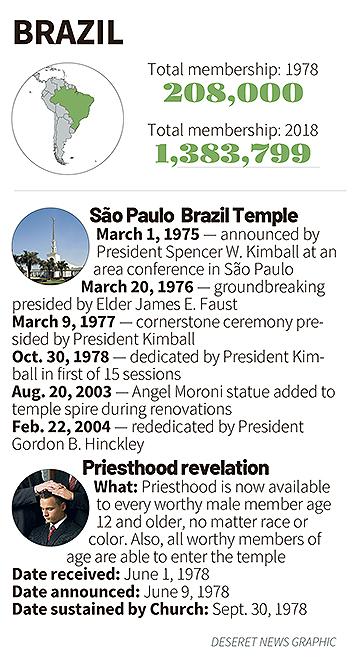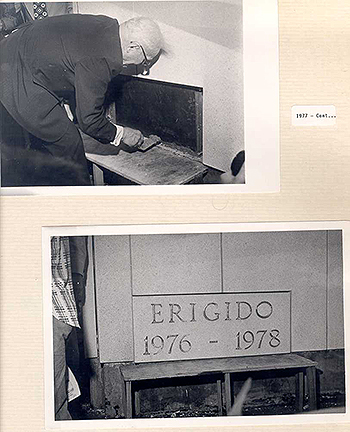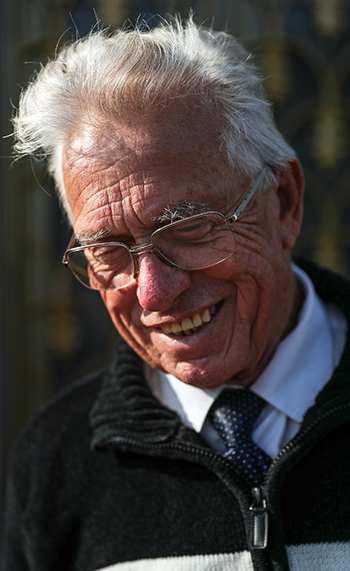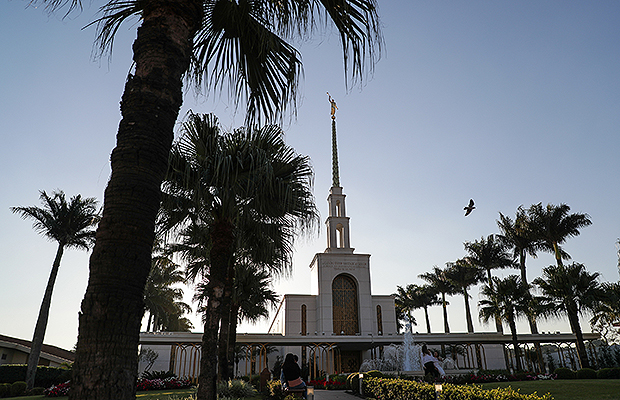How a 1978 Revelation and a Temple Changed Everything in Brazil
Contributed By Scott Taylor, Church News Managing Editor

The São Paulo Brazil Temple as seen early in the morning on May 24, 2018. Photo by Spenser Heaps, Deseret News.
Related Links
SÃO PAULO, BRAZIL
For Nilo Maria Leal, the patriarchal blessing he received after the 1966 creation of the São Paulo Brazil Stake stated he would one day be in the temple with his family.
“It was an impossible dream,” he recalled. “We had no perspective. The temple was not expected.”
For Marcelo Leite Silveira, who was 4 years old when his parents were baptized in 1959, the closest temple for the next 15 years was in Mesa, Arizona, some 5,800 miles away from São Paulo. The 1974 addition of the Washington D.C. Temple cut the distance to 4,700 miles.
“We had the feeling that a temple in Brazil would be very difficult,” he remembered, “that it would be many, many years before we would have a temple here.”
And for Helvécio Martins, unable to receive the priesthood after his 1972 baptism because of his black African ancestry and the restrictions of the day, the temple was not even a consideration—except that in a meeting with President Spencer W. Kimball a couple of years after his baptism, the prophet promised him that if he was faithful and exercised fidelity, all blessings would at some time be his.
For these and the other 208,000 Saints living in Brazil in 1978, it was as if the windows of heaven opened with an abundance of blessings coming in the wake of two key events that year—the June 9 announcement of the revelation affording the priesthood to be given to all worthy male members ages 12 and older, and the October 30 dedication of the São Paulo Brazil Temple.
De mãos dadas. That’s Portuguese for “hand-in-hand.” And that’s the best way to describe how these two events served as a catalyst for tremendous Church growth in the four decades since.
Priesthood revelation
In addition to the native Amerindians comprising the area’s indigenous tribal populations, Portuguese settlers and African slaves arrived in the 16th century, with the Great Immigration of the late 19th and early 20th centuries resulting in a substantial increase of European immigrants as well as others from Japan, the Middle East, and Eastern Europe.
The Church traces its early Brazilian roots to the late 1920s in the country’s southern reaches and predominant European influences; the first members were German immigrants, and German was the first language used by missionaries, later followed by Brazilian Portuguese. Much of the population with black African heritage is found farther north, starting in São Paulo and increasing dramatically throughout north and northeastern Brazil, especially along the coastal areas.
With the Church’s restriction at the time regarding the priesthood, Church members with black African ancestry—such as the Martins family in Rio de Janeiro—knew priesthood offices and callings as well as temple opportunities were out of the question. And missionaries who came in contact with black individuals and families who were not members would provide an initial message, teach them how to pray, and then back away from pursuing a return appointment.
Then came the June 9, 1978, announcement regarding the priesthood. For black Latter-day Saints—like the Martins family in Rio and others throughout the world—the priesthood and the temple became immediate blessings, while the missionary work among the blacks in Brazil became unshackled.
“The revelation opened the door to every family,” said Elder Marcos A. Aidukaitis, a General Authority Seventy who presides over the Church’s Brazil Area.
A native of Porto Alegre, Brazil, Elder Aidukaitis began his own missionary service in São Paulo a year after the 1978 announcement. “We taught everybody in Brazil. And I think that’s why the Church exploded in terms of its membership.”
Said Silveira, choking back tears as he remembered the revelation’s result: “It was difficult not to cry when we saw a black boy passing the sacrament. And things like that show how the Lord is conducting the work. We understand why we are the Latter-day Saints.”
A temple for Brazil

The priesthood revelation and the Sao Paulo Temple dedication served as catalysts for growth in Brazil. Graphic by Aaron Thorup, Deseret News.

The São Paulo Brazil Temple during construction between 1976 and 1978. Photo courtesy of Church history archives.

The São Paulo Brazil Temple during construction between 1976 and 1978. Photo courtesy of Church history archives.

President Spencer W. Kimball attends the 1975 São Paulo Area Conference in São Paulo, Brazil. Photo courtesy of Church history archives.

A page shows a photograph of President Marion G. Romney, a counselor in the First Presidency, sealing the cornerstone of the São Paulo Temple in 1977, as well as a photograph of the sealed cornerstone. President Spencer W. Kimball presided at the cornerstone ceremony. Photo courtesy of Church history archives.

Luiz Pires de Godoy poses for a photograph outside the São Paulo Brazil Temple on May 23, 2018. Photo by Spenser Heaps, Deseret News.

LDS Church members volunteer to help with construction of the São Paulo Brazil Temple between 1976 and 1978. Photo courtesy of Church history archives.
While the revelation announcement came suddenly and unexpectedly, the dedication of the temple was a climax several years in the making. It started during a March 1, 1975, area conference in a downtown São Paulo convention center, when President Kimball announced plans to build a temple in that city.
“It was a dream come true,” said Leal.
Added his wife, Sheila: “It was a time full of joy.”
Up to that point, only a relatively few Brazilian Saints had either gone to a temple in the United States or would do so prior to the opening of the São Paulo Temple—either the members had the financial means to do so, or they were stake presidency members or bishops invited by the Church to Utah for training and temple ordinances to help them in their leadership responsibilities back in Brazil.
Such was the case for Demar and Sandra Staniscia. Sent to the October 1973 general conference while he served as a stake presidency counselor, the two received their temple endowments and were sealed in the Salt Lake Temple, a half-dozen years after their 1966 civil marriage and 1967 baptism.
A year after the temple announcement, Elder James E. Faust, then of the Presidency of the Seventy, presided over the 1976 groundbreaking. The property west of São Paulo’s Pinheiros River was then cleared of brush, weeds, and banana trees, with a meetinghouse, area offices, and patron housing to be constructed on the lot alongside the temple.
The temple would be not only Brazil’s first, but the first in South America. As such, the new temple district included nine entire nations—Argentina, Bolivia, Brazil, Chile, Colombia, Ecuador, Peru, Paraguay, and Uruguay—and donations came from members and families across the continent, with the principal amount raised in Brazil.
Contributions of money and work
Members donated their savings, sold their gold and jewelry, and cut back on daily expenses and planned purchases to help fund their part of the financial assessments. Children and youth also got involved, forgoing allowances or, like their adult counterparts, selling personal possessions.
“They would find something like a chess game they would have and sell it for a couple of dollars so they could donate those $2 for the building of the temple,” said Elder Adilson de Paula Parrella, a General Authority Seventy from Guarujá in the state of São Paulo and current counselor in the Brazil Area Presidency.
“Financially speaking, that would probably make little or no difference. But I think it helped build and strengthen the members’ and the youth’s understanding about the temple and how sacred it is and what it would mean in their lives.”
Member volunteers helped with construction efforts, including building the neighboring meetinghouse and creating the 50,000 blocks of exterior stone—similar to that used on the Provo, Ogden, Idaho Falls, Oakland, and Los Angeles Temples. The blocks featured a mixture of small marble chips into white cement, followed by a silicone coating.
Luiz Pires de Godoy, who was baptized in February 1974 in Curitiba and then moved soon to São Paulo after a severe car accident nearly claimed his wife’s life and resulted in severe spinal injuries, found himself regularly at the construction site building blocks and doing any number of necessary tasks.
“We worked here on Saturdays. We wrote our names, our ward and stake names, and our I.D. number, and then we got to work,” said de Godoy, who later worked as a temple employee in general maintenance from 1979 to 2006 as well as a long-time temple ordinance worker.
Temple names with a twist
Leaders sought to have 10,000 new temple recommend holders prior to dedication and encouraged members to submit four-generation genealogy sheets, which would provide as many as 100,000 names for temple work.
Up to that point, all genealogical records and name submissions for temple work went through Church headquarters in Salt Lake City. But the São Paulo Temple would be the first independent temple where names could be reviewed and approved locally for temple use.
Staniscia, whose three decades of work in the Brazil Area office included overseeing the Genealogical Department for the country and other parts of South America, relocated with his family to Salt Lake City for the last half of 1977 to learn the processes and return to teach area and stake personnel to implement the new genealogical procedures.
With construction completed, an open house was held to welcome visitors to tour the temple. Returned missionaries and their spouses served as tour hosts, and members offered open house tickets to their friends and neighbors; de Godoy and his wife distributed more than 1,000 themselves.
Dedication and opening
President Kimball, who had announced the temple in 1975, presided at its cornerstone sealing in 1977, and announced the June 1978 priesthood revelation, returned to São Paulo to dedicate the temple on October 30, 1978, the first of 15 sessions held over several days.
With the temple now available for members to do their own temple ordinances as individuals and families as well as for their ancestors, Octávio Bautista de Carvalho, who as a bishop had been invited for training in Utah in 1976 and went to both the Provo and Los Angeles Temples, was enlisted to help gather individuals to attend the first endowment session in the new temple.
And a month later, he was sealed to his wife, Leda, who was unable to accompany him to the United States in 1976.
“It was a great thing for me,” he said. “Because when I wasn’t a member of the Church, I always wondered how it would be after this life. I had no hope of eternal life, and I was really sad because of that. Then when I learned that families could be eternal and that I could be sealed to my wife and children, it was very special.”
Today
By the mid-1980s, temples started to dot South America, first in Santiago, Chile; Lima, Peru; and Buenos Aires, Argentina. But for 22 years, the São Paulo temple was the only one in Brazil, a country almost the size of the United States. Then, one December week in 2000, temples were dedicated in Recife and Porto Alegre. Today Brazil is home to six temples (others are in Campinas, Curitiba, and Manaus), two more under construction (in Fortaleza and Rio de Janeiro), and another two are awaiting groundbreaking (Belém and Brasilia).
Longtime Brazilian members—including those interviewed for this report—have now served as bishops and presidents or counselors of stakes, missions, and temples. Many have served as temple ordinance workers, temple sealers, and patriarchs. Elder Helvécio Martins was called as a member of the Second Quorum of the Seventy, serving five years as a General Authority Seventy.
Peers and spouses have passed away, Elder Martins himself in 2005. But their second and third generations in Brazil and beyond today carry forward—holding the priesthood, fulfilling the callings, and filling the temples.
In hand-in-hand manner.

São Paulo Brazil Temple is seen at sunset on May 23, 2018. Photo by Spenser Heaps, Deseret News.

Marcos Silva, 18, reads a copy of the Book of Mormon outside the São Paulo Brazil Temple before going to work for the day in the Church’s area offices in São Paulo, Brazil, on May 24, 2018. Photo by Spenser Heaps, Deseret News.

Sandra and Demar Staniscia pose for a photo with a shovel used in the groundbreaking ceremony for the São Paulo Brazil Temple at their apartment in São Paulo, Brazil, on May 23, 2018. Photo by Spenser Heaps, Deseret News.

Leda dos Santos Guimaraes de Carvalho and her husband, Octávio Batista de Carvalho, greet Luiz Pires de Godoy outside the São Paulo Brazil Temple while arriving to meet with journalists on May 23, 2018.

Luiz Pires de Godoy shows off tickets to the 1978 dedication of the São Paulo Brazil Temple while talking to journalists in the Church’s area offices in São Paulo, Brazil, on May 23, 2018.

The São Paulo Brazil Temple is seen at sunset on May 23, 2018. Photo by Spenser Heaps, Deseret News.

Demar and Sandra Staniscia pose with photos from their wedding at their apartment in São Paulo, Brazil, on May 23, 2018. Photo by Spenser Heaps, Deseret News.

Luiz Pires de Godoy poses for a photograph outside the São Paulo Brazil Temple on May 23, 2018. Photo by Spenser Heaps, Deseret News.

The São Paulo Brazil Temple is seen at sunset on May 22, 2018. Photo by Spenser Heaps, Deseret News.

A photo showing the baptismal font in the São Paulo Brazil Temple during construction between 1976 and 1978. Photo courtesy of Church history archives.

With over 12 million residents, expanses of tall buildings define views of São Paulo, Brazil, on Sunday, May 20, 2018. Photo by Spenser Heaps, Deseret News.

With over 12 million residents, expanses of tall buildings define views of São Paulo, Brazil, on Sunday, May 20, 2018. Photo by Spenser Heaps, Deseret News.
